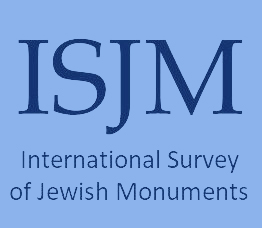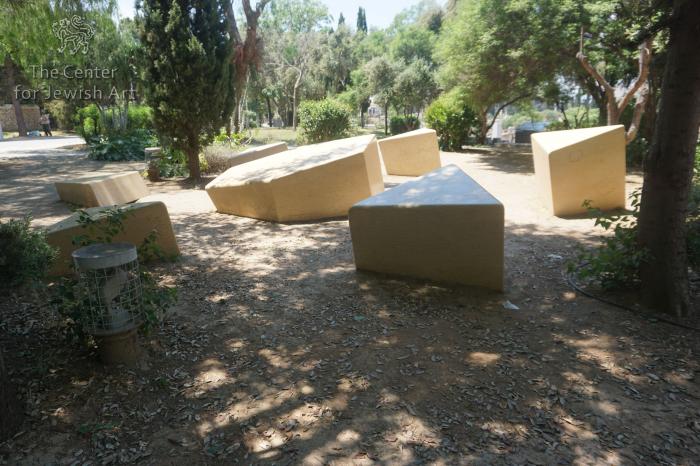Obj. ID: 44817 Greek National Holocaust Memorial in Athens, Greece, 2010

Name
Greek National Holocaust Memorial
Who is Commemorated?
Greek-Jewish victims of the Holocaust
Description
The monument consists of stones laid down in the form of a Star of David set within a planted garden. Engraved on the stones are the names of Greek towns and cities whose Jewish communities were annihilated during the Holocaust.
At one end of the memorial garden is a rectangular brown sign on a tall pole that says in Greek and English “The Holocaust Memorial in Athens.” At the other end, just off the main pedestrian walkway, is a low marble base with a slated top, upon which are affixed three metal plaques with a quotation from Nobel Laureate Elie Wiesel in French, Greek, and English.
At the center of the garden is the monument, a low sculptural composition that at first looks like scattered stones. but is revealed to be seven stones arranged in the pattern of a Magen David, with the pointed “arms” of the star cut way and spread out in all directions. These are arranged as the points of compass, around a larger central hexagonal stone. All but the central stone point to the cities and villages across Greece from where tens of thousands of Jews were gathered and deported. The names of the Jewish communities in the direction on the compass are carved directly on each stone.
The stones appear to have been coated with an anti-graffiti film which darken the stone, and which as of May 2022 was peeling, giving the monument surfaces an uneven appearance.
Planted around the monument is a herbal garden as a metaphor for place, healing and memory. Herbs from around Greece are planted in accordance to the orientation of the star. People can walk through and around the monument as in a garden. The orientation of the Star of David and the smell from the herbs all act together as a catalyst of memory and a tribute the dead and lost homelands.
Inscriptions
Plaques at entrance with a quotation from Nobel Laureate Elie Wiesel in French, Greek, and English:
In French
Passant, arrête-toi, ferme les yeux et souviens toi.
Souviens-toi qu’en ce temps-là, en ce lieu ou pas loin d’ici,
de nombreux hommes, femmes et enfants,
tes concitoyens paisibles et confiants, ont été arrêtés,
humiliés et condamnés à une mort brutale
dans des camps dits d’extermination qui resteront
à tout jamais la honte de la civilisation européenne.
Parce qu’ils étaient juifs, six millions d’êtres humains
ont été prives du droit à la liberte, au bonheur, à l’espérance,
au sourire et à la prière, et tout simplement à la vie.
Souviens-toi de leur vie, de leur agonie et de leur mort.
Ne pleure pas, ne crie pas devant tant de souffrance
et tant d’horreur : ne laisse pas le colère et le désespoir
peser sur ton avenir.
Fais de la mémoire un acte de justice et d’honneur
pour empêcher l’ennemi d’hier de tuer ses victimes
d’une deuxième mort – par l’oubli.
Elie Wiesel
pour le monument de l”holocaust à Athènes mai 2010
In Greek
Διαβάτη στάσου, κλείσε τα μάτια και θυμήσου,
Θυμήσου, τότε, κάπου εδώ, συμπολίτες σου φιλήσυχους
και ανέμελους, άνδρες, γυναίκες και παιδιά, συνέλαβαν,
ταπείνωσαν και καταδίκασαν σε θάνατο αποτρόπαιο,
σε στρατόπεδα εξόντωσης, που θα’ναι για πάντα η ντροπή
του ευρωπαϊκού πολιτισμού.
Επειδή ήσαν Εβραίοι, έξι εκατομύρια ψυχές στερήθηκαν
το δικαίωμα στην ελευθερία, την ευτυχία, την ελπίδα,
στο χαμόγελο και την προσευχή, στην ίδια τη ζωή.
Θυμήσου τη ζωή, την αγωνία και το θάνατό τους.
Χωρίς θρήνους και χωρίς κραυγές για τον πόνο και τη φρίκη.
Μην αφήσεις ο θυμός και η απελπισία να βαρύνουν
το μέλλον σου. Ας είναι η θύμησή σου δικαίωση και τιμή,
εμπόδιο στον χθεσινό εχθρό να σκοτώσει τα θύματά του
με δεύτερο θάνατο – τη λήθη.
Ελί Βιζέλ
In English
Pause awhile as you pass by,
close your eyes and remember.
Remember the time when here, or near here,
men, women and children - our own fellow creatures –
congregated in peace and trust, only to be arrested,
humiliated, deported and murdered in Camps
that shall forever shame our Civilization.
Because they were Jewish, 6 million people
we're denied the right to be free, happy, to hope,
to smile, to pray and finally, the right to live.
Remember them, their anguish and their death.
Do not recoil at such horror; do not descend into despair
At man's inhumanity to man.
Just remember. For by remembering we honor their deaths,
and we save them from dying again - in oblivion.
Elie Wiesel
For the Holocaust Memorial in Athens May 2010
The stones are inscribed with the names of Jewish destroyed communities
POΔΟΣ
ΣΩΣ
XANIA
HPAKΛΕΙΟ
ΠPEBEVA
ΠATPA
ZAKYNΘOΣ
AΓPINIO
KEPKYRA
ΩANNINA
KAΣTOPIA
ΦΛΩRINA
APTA
TPIKAΛA
KAPΔITΣA
ΘΕΣΣΑΛΟΝΙΚΗ
KΑΒΑΛΑ
ΔΡΑΜΑ
ΣΕΡΡΕΣ
ΞΑΝΘΗ
ΛΑΡΙΣΑ
BEPOIA
BOΛOΣ
XAΛKIΔA
ΔIΔYMOTEIXO
AΘΗΝΑ
KOMOTHINH
NEA OPEΣTIAΔA
ΣOYΦΛΙ
AΛΕΞΑΝΔΡΟΥΠΟΛΗ
Translation: Rhodes / Kos Chania / Herakleion Preveza / Patras / Zakynthos / Agrinion Corfu / Ioannina / Kastoria / Florina / Arta / Trikala / Karditsa Thessoloniki / Kavala / Drama / Serres / Xanthi / Larissa / Veroia / Volos / Halkis Didimoticho / Athens / Komotini / New Orestiada / Soufli / Alexandroupolis
On the side of the central stone is inscribed in small letters:
ΔΩΡΕΑ ΖΑΚ Κ ΔΕΣΠΟΙΝΑ ΑΛΑΖΡΑΚΗ
ΓΛΥΠΤΗΣ ΝΤΙΑΝΝΑ ΜΑΓΚΑΝΙΑ
Translation: Donation of Zak and Despoina Alazraki / Sculptor DeAnna Maganias
Commissioned by
City of Athens, Jewish Community of Athens, Central Board of Jewish Communities in Greece and the Athens Jewish Community, Zak and Despoina Alazraki (financial sponsors)
On March 25, 1944, German officials rounded up 1,690 Jews in Athens for deportation. Many were refugees from Thessaloniki and other towns who had taken refuge in Athens during the Italian occupation. In April, about 1,900 Jews were deported from Athens to Auschwitz-Birkenau. 1,300 of them came from Athens, the remaining 600 were from the regions of Preveza, Arta, Agrinio and Patras who had previously been deported to the Chaidari transit camp north-west of Athens. In total, about 59,000 Jews from Greece were murdered during the Holocaust.
After 1945, Athens became the center for Jews who returned to Greece, and the city’s Jewish reached almost 5,000. Today Athens remains the center of Jewish life in Greece. The center of Jewish life has been the tow synagogues and community offices and social facilities on Melidoni Street, not far from the location of the Holocaust Monument.
According to historian Anna Maria Droumpouki:
“In 2004, the President of the Central Board of Jewish Communities in Greece Moses Konstantinis, in his meeting with the mayor of Athens Dora Bakoyianni, raised again the issue of constructing a central memorial for the Holocaust, stressing that ‘the lack of such a monument constitutes essential omission for the capital of Greece’ (Sakis Leon private archive [SLA], letter 867, 21 October 2004). The matter remained on the official ‘agendas’ because, according to Konstantinis, ‘for various reasons the Municipality does not wish the erection of a monument’ (SLA, letter 867, 21 October 2004)....
The municipality questioned the functionality of locating a modern ‘Jewish’ monument near antiquities dating from the fifth century BC on the grounds that there would be a ‘contest with the ancient marbles’ (SLA, Municipality of Athens, dossier 064540). It was stated that the space that the community demanded had concrete historical and archaeological character in which ‘the monument for the Holocaust cannot be included harmoniously’ (SLA, Municipality of Athens, dossier 064540). The state has its own national framework concerning Greek antiquity, and the Nazis’ persecution of Greek Jews, tolerated or even supported by a large number of the Greek population, was clearly excluded from this glorified national imagining. Greek society does not incorporate the memories of its conflicted and painful recent past, and Jews stand for this repressed past.”
In 2008, however, the municipality of Athens donated land near the ancient Keramikos cemetery as the site for a national Holocaust memorial. The site overlooks the ancient cemetery, now a publicly accessible archaeological site and is close to the synagogue in Melidoni street where Jews of Athens were trapped and captured by the Germans, but which remains the religious and administrative center of the Jewish community today.
There was an international competition sponsored by the Jewish Community, with 19 proposals received from well-known artists. A special committee chose the proposal of the Greek American artist DeAnna Maganias for its simplicity of design and symbolism. After long discussions between the Jewish community, the municipality, and the authority of Antiquities (SLA, Municipality of Athens, dossier 064540) the monument had to be reduced by 50% from the size originally foreseen, because of the size of the space provided.
According to a newspaper account at the time of dedication (The Guardian, May 9, 2010):
"In keeping with the Jewish tradition, it symbolized death and the memory of death in a quiet and calm way," said a committee member who oversaw an international competition for the memorial. The marble monument, which is set in a herb garden, is also about healing. "The herbal garden is a symbol of healing and place," said Maganias. "The idea is that people walk around the monument. The orientation of the star, engraved with the names of cities and towns from which victims were deported and the smell from the herbs aim to act as a catalyst of memory."
The memorial was vandalized twice in 2014 and again in 2017.
DeAnna Maganias website, https://www.deannamaganias.com/ (accessed September 22, 2022)
Droumpouki, Anna Maria, “Shaping Holocaust Memory in Greece:
memorials and their public history,” National Identities, DOI: 10.1080/14608944.2015.1027760, https://www.tandfonline.com/doi/full/10.1080/14608944.2015.1027760 (accessed September 22, 2022)
Smith, Helena. “Athens unveils its first Holocaust memorial,” The Guardian, May 9, 2010, https://www.theguardian.com/world/2010/may/09/athens-holocaust-memorial (accessed September 22, 2022)
“Holocaust Memorial,” Jewish Community of Athens, https://athjcom.gr/english/jewish-memorials/holocaust-memorial/ (accessed September 22, 2022)
“Holocaust memorial in Athens with Elie Wiesel inscription is vandalized,” Jewish Telegraphic Agency, December 4, 1017. , https://www.jta.org/2017/12/04/global/holocaust-memorial-in-athens-vandalized (accessed September 22, 2022)























